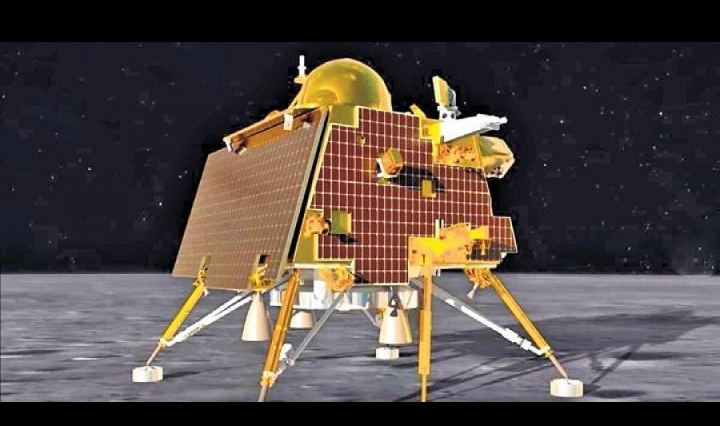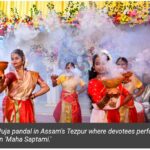Mythical link between NCERT and Chandrayaan-3
NCERT’s reading module for middle school students, ‘Chandrayaan Utsav’, aims to create awareness among students about the mix of science and mythology.
The National Council of Educational Research and Training (NCERT) is once again embroiled in controversy. A reading module on India’s successful Chandrayaan-3 mission and successful landing near the moon’s south pole has been introduced to middle school students. The ‘Chandrayaan Utsav’ module is aimed at increasing awareness among students and combines science and mythology. This has infuriated many scientists, who are calling for the module to be withdrawn. The module was launched by Education Minister Dharmendra Pradhan(NCERT ) in New Delhi on October 17.
In the presence of ISRO Chairman Mr. S. Somanath. The 17-page introduction to the module says, “Did this scientific achievement only happen now?” Didn’t this happen in the past too? Didn’t people think about this before?
According to the literature, its origins can be traced back to the Vimanika Shastra, The Science of Aviation; The book shows that our country had knowledge of flying vehicles at that time and even puts the “structure, engine operation, and gyroscope system” on a pedestal of ancient Indian mythology.
A study by the Aeronautical Engineering Department of the Indian Institute of Science (IISc) has revealed that the book Vimanika Shastra was written in 1923 by Sanskrit linguist Subbaraya Shastri. “(IISc) research has proven that these aircraft cannot fly according to the laws of aerodynamics and Newton’s laws of motion. An aircraft built on these ideas would undoubtedly have been successful.
A terrible accident. And these are just the imaginative ideas of the authors,” said Dipti B, state secretary, Breakthrough Science Society (BSS), Bengaluru. This module quotes the Vedas, which mention various gods who use flying chariots with wheels, calling them “mechanical birds.”
These works can be described as science fiction.
The document also states that the gods used to travel from Earth to heaven, planets, and other cosmic destinations in these vehicles, called “locomotives.” There is also mention of the Pushpak Vimana, a floating chariot used by Ravana in the Ramayana and said to have been built by Guru Vishwakarma, the chief architect of the gods. In response to this, former ISRO Chairman G. Madhavan Nair said:
“The rishis may have had the idea of developing flying vehicles and their applications, but there is no evidence in our documents to support that claim. “There must be some ruins in Sri Lanka or India,” he said, adding that these works could be called “science fiction.”
“The physical reality of the rishis’ thoughts and observations, including advanced military weaponry, is what we can see today,” he said. Scholars said that fantasy was an integral part of storytelling, Vedic literature, and epic poetry without resulting in uninteresting and monotonous stories. “Enjoy the imaginary, keeping in mind that these are imaginary and not actual historical facts,” BSS said in a statement. BSS called on the Union government to stop promoting myths as historical facts. “Such false claims would be an insult to India’s genuine contribution to the world of science,” Dipti said. Meanwhile, excerpts from the supplementary reading were spread on social media, with netizens debating the issue and vehemently rejecting the claims made in the module.
The post had been viewed more than 384,000 times on Platform X as of 9:20 p.m. Saturday. The BSS urges the public to raise awareness about India’s real contribution in the world of science and to disbelieve such unscientific claims.
There is also mention of the floating chariot ‘Pushpak Vimana’ used by Ravana in the Ramayana and said to have been built by Guru Vishwakarma, the chief architect of the Devas. Reacting to this, former ISRO Chairman G. Madhavan Nair said, “The rishis may have had ideas about flying vehicles and their applications, but there is no evidence to support the claims in our document.” ” he said. As far as Pushpaka Vimana is concerned, there must be ruins either in Sri Lanka or India,” he said, adding that these works could be called “science fiction”. “The physical reality of the rishis’ thoughts and observations, including advanced military weaponry, is what we can see today,” he said. Scholars said that fantasy is an integral part of storytelling, Vedic literature, and epic poetry, and does not result in uninteresting and monotonous stories.
“We should enjoy the imaginary, keeping in mind that these are imaginary and not actual historical facts,” BSS said in a statement. BSS called on the Union government to stop promoting myths as historical facts.
“Such false claims would be an insult to India’s genuine contribution to the world of science,” Dipti said. Meanwhile, excerpts from the supplementary reading were spread on social media, with netizens debating the issue and vehemently rejecting the claims made in the module. The post had been viewed more than 384,000 times on Platform X as of 9:20 p.m. Saturday. The BSS urges the public to raise awareness about India’s real contribution in the world of science and to disbelieve such unscientific claims.
For more information visit at https://happenrecently.com/zepto/?amp=1
Source: www.indianexpress.com



